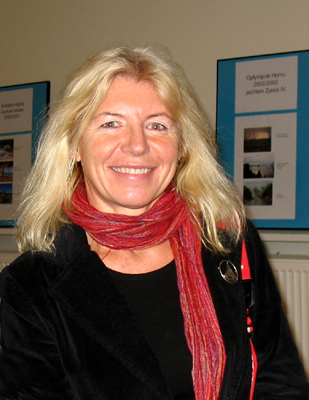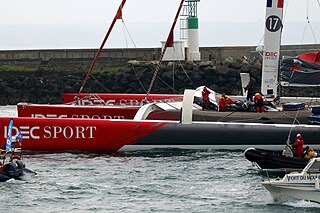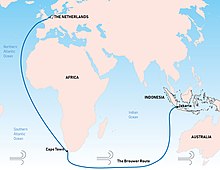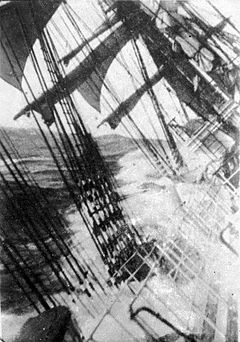
Circumnavigation is the complete navigation around an entire island, continent, or astronomical body. This article focuses on the circumnavigation of Earth.

Yacht racing is a sailing sport involving sailing yachts and larger sailboats, as distinguished from dinghy racing, which involves open boats. It is composed of multiple yachts, in direct competition, racing around a course marked by buoys or other fixed navigational devices or racing longer distances across open water from point-to-point. It can involve a series of races with buoy racing or multiple legs when point-to-point racing.

Flying Cloud was a clipper ship that set the world's sailing record for the fastest passage between New York and San Francisco, 89 days 8 hours. The ship held this record for over 130 years, from 1854 to 1989.

Sir Francis Charles Chichester KBE was a British businessman, pioneering aviator and solo sailor.

The Vendée Globe is a single-handed (solo) non-stop round the world yacht race. The race was founded by Philippe Jeantot in 1989, and since 1992 has taken place every four years. It is named after the Département of Vendée, in France, where the race starts and ends. The Vendée Globe is considered an extreme quest of individual endurance and the ultimate test in ocean racing.

The Jules Verne Trophy is a prize for the fastest circumnavigation of the world by any type of yacht with no restrictions on the size of the crew provided the vessel has registered with the organization and paid an entry fee. A vessel holding the Jules Verne trophy will not necessarily hold the absolute round the world record. The trophy was first awarded to the first yacht which sailed around the world in less than 80 days. The name of the award is a reference to the Jules Verne novel Around the World in Eighty Days in which Phileas Fogg traverses the planet in 80 days. The current holder is IDEC Sport skippered by Francis Joyon in 40 days 23 hours 30 minutes 30 seconds.

Gipsy Moth IV is a 53 ft (16 m) ketch that Sir Francis Chichester commissioned specifically to sail single-handed around the globe, racing against the times set by the clipper ships of the 19th century.

Sir William Robert Patrick Knox-Johnston is a British sailor. In 1969, he became the first person to perform a single-handed non-stop circumnavigation of the globe. Along with Sir Peter Blake, he won the second Jules Verne Trophy, for which they were also named the ISAF Yachtsman of the Year award. In 2007, at the age of 67, he set a record as the oldest yachtsman to complete a round the world solo voyage in the Velux 5 Oceans Race.
Dame Naomi Christine James, DBE is the first woman to have sailed single-handed around the world via Cape Horn, the second woman to have ever sailed solo around the world. She departed Dartmouth, Devon on 9 September 1977 and finished her voyage around the globe on 8 June 1978 after 272 days, thus improving Sir Francis Chichester's solo round-the-world sailing record by two days.

Bernard Moitessier was a French sailor, most notable for his participation in the 1968 Sunday Times Golden Globe Race, the first non-stop, singlehanded, round the world yacht race. With the fastest circumnavigation time towards the end of the race, Moitessier was the likely winner for the fastest voyage, but he elected to continue on to Tahiti and not return to the start line in England, rejecting the idea of the commercialization of long distance sailing. He was a French national born and raised in Vietnam, then part of French Indochina.
The sport and practice of single-handed sailing or solo sailing is sailing with only one crewmember. The term usually refers to ocean and long-distance sailing and is used in competitive sailing and among Cruisers.

In sailing, the great capes are three major capes of the continents in the Southern Ocean—Africa's Cape of Good Hope, Australia's Cape Leeuwin, and South America's Cape Horn.

The Sunday Times Golden Globe Race was a non-stop, single-handed, round-the-world yacht race, held in 1968–1969, and was the first round-the-world yacht race. The race was controversial due to the failure of most competitors to finish the race and because of the apparent suicide of one entrant; however, it ultimately led to the founding of the BOC Challenge and Vendée Globe round-the-world races, both of which continue to be successful and popular.

Cape Horn is the southernmost headland of the Tierra del Fuego archipelago of southern Chile, and is located on the small Hornos Island. Although not the most southerly point of South America, Cape Horn marks the northern boundary of the Drake Passage and marks where the Atlantic and Pacific Oceans meet.

David Scott Cowper is a British yachtsman, and was the first man to sail solo round the world in both directions and was also the first to successfully sail around the world via the Northwest Passage single-handed.

Joanna "Asia" Pajkowska is a Polish sailor, with a rank of captain, a sea life guard, she sailed over 250,000 nautical miles, often in singlehanded or in two-handed races. She is one of the best-known sailors in Poland and one of the most experienced ocean sailors in the world. In 2018 she completed, as the first Polish female sailor, singlehanded non-stop circumnavigation.

The first around the world sailing record for circumnavigation of the world can be attributed to the surviving crew of Ferdinand Magellan's expedition, including the last captain Juan Sebastián Elcano who completed their journey in 1522.
Lisa Blair is an Australian solo sailor who holds multiple world records. She is also an advocate for climate change, which she promotes through her Climate Action Now project. She has written a book, Facing Fear, about her first attempt at circumnavigating Antarctica solo on her yacht Climate Action Now.
The Global Solo Challenge is a single-handed (solo) non-stop round the world yacht race. The race was founded by Marco Nannini.


















